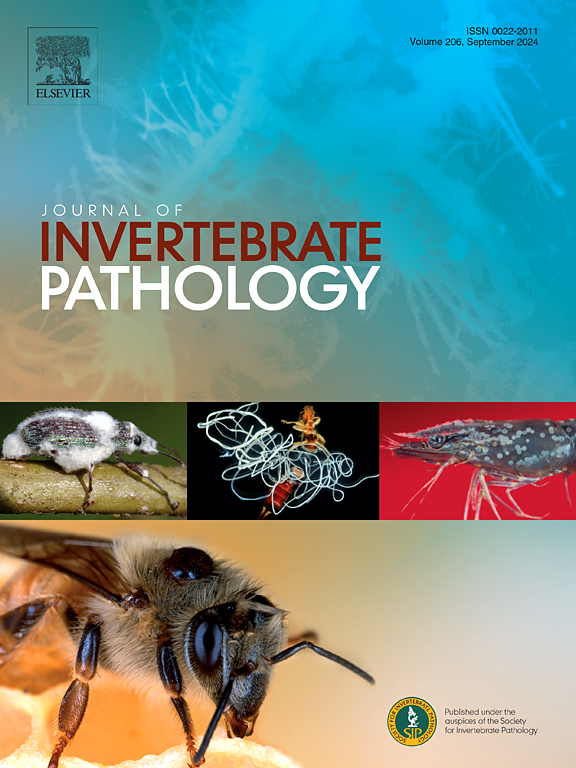Where are my nematodes? labelling and visualising entomopathogenic nematodes in vivo using carbon quantum dots
IF 2.4
3区 生物学
Q1 ZOOLOGY
引用次数: 0
Abstract
Identifying single or groups of animals has significantly advanced our understanding of animal biology and ecology. However, labelling is extremely difficult in small animals, like soil invertebrates. Due to the complexity of current methods, the dynamics and interactions of these populations are often studied indirectly. Labelling nematodes or microarthropods such as collembolans or soil acari has been challenging due to the high cost, potential toxicity, genetic modification requirements, cellular processes interference, and photobleaching. In this scenario, no methods can be applied to large numbers of microorganisms at once due to their mentioned practical and biological limitations and cost. In this work we show that quantum carbon dots (Cdots) are effective for labelling infective juveniles (IJs) of entomopathogenic nematodes (EPNs). In in vitro assays the IJs gradually acquired fluorescence, as Cdots accumulated in the lysosome-related organelles from their intestine cells, peaking at day 14, and with no lethal or sub-lethal effects on IJs. Fluorescence was clearly distinguishable from the natural auto-fluorescence of non-labelled IJs and persisted for months in IJs transferred to water. We and non-experts easily differentiated between similar species of EPNs and between two strains of S. feltiae placed in the same matrix (soil or water). We demonstrated for the first time the feasibility of labelling large numbers of IJs (hundreds of thousands/millions) with Cdots at minimal cost without any adverse effects for over a year. Our findings could be the starting point for detailed and large-scale field investigations on nematodes and other small organisms, allowing deeper understanding of their roles in soil ecosystems. This method provides a cost-effective and reliable tool for advancing research in the ecology of soil invertebrates, such as the interactions occurring in communities or between specific organisms, movement and dispersal, population dynamics or ecosystem services in a cryptic environment difficult to study.

我的线虫在哪里?利用碳量子点在体内标记和可视化昆虫病原线虫。
识别单个或群体的动物大大提高了我们对动物生物学和生态学的理解。然而,对土壤无脊椎动物等小动物进行标记是极其困难的。由于现有方法的复杂性,这些种群的动态和相互作用往往是间接研究的。由于成本高、潜在毒性、基因改造要求、细胞过程干扰和光漂白等原因,标记线虫或微节肢动物(如collebolans或土壤螨)一直具有挑战性。在这种情况下,由于上述方法的实用性和生物学局限性以及成本,没有任何方法可以同时应用于大量微生物。在这项工作中,我们证明了量子碳点(Cdots)对昆虫病原线虫(EPNs)的感染性幼虫(IJs)的标记是有效的。在体外实验中,随着Cdots在肠细胞溶酶体相关细胞器中积累,IJs逐渐获得荧光,在第14天达到峰值,对IJs没有致死或亚致死作用。荧光与未标记的IJs的天然自身荧光明显不同,并且在转移到水中的IJs中持续数月。我们和非专家很容易区分相似种类的epn和放置在相同基质(土壤或水)中的两株S. feltiae。我们首次证明了在一年多的时间里,以最低的成本用Cdots标记大量ij(数十万/数百万)的可行性,没有任何不良反应。我们的发现可以为线虫和其他小生物的详细和大规模实地调查提供起点,使人们能够更深入地了解它们在土壤生态系统中的作用。该方法为推进土壤无脊椎动物生态学的研究提供了一种经济可靠的工具,例如在难以研究的神秘环境中发生的群落或特定生物之间的相互作用,运动和扩散,种群动态或生态系统服务。
本文章由计算机程序翻译,如有差异,请以英文原文为准。
求助全文
约1分钟内获得全文
求助全文
来源期刊
CiteScore
6.10
自引率
5.90%
发文量
94
审稿时长
1 months
期刊介绍:
The Journal of Invertebrate Pathology presents original research articles and notes on the induction and pathogenesis of diseases of invertebrates, including the suppression of diseases in beneficial species, and the use of diseases in controlling undesirable species. In addition, the journal publishes the results of physiological, morphological, genetic, immunological and ecological studies as related to the etiologic agents of diseases of invertebrates.
The Journal of Invertebrate Pathology is the adopted journal of the Society for Invertebrate Pathology, and is available to SIP members at a special reduced price.

 求助内容:
求助内容: 应助结果提醒方式:
应助结果提醒方式:


